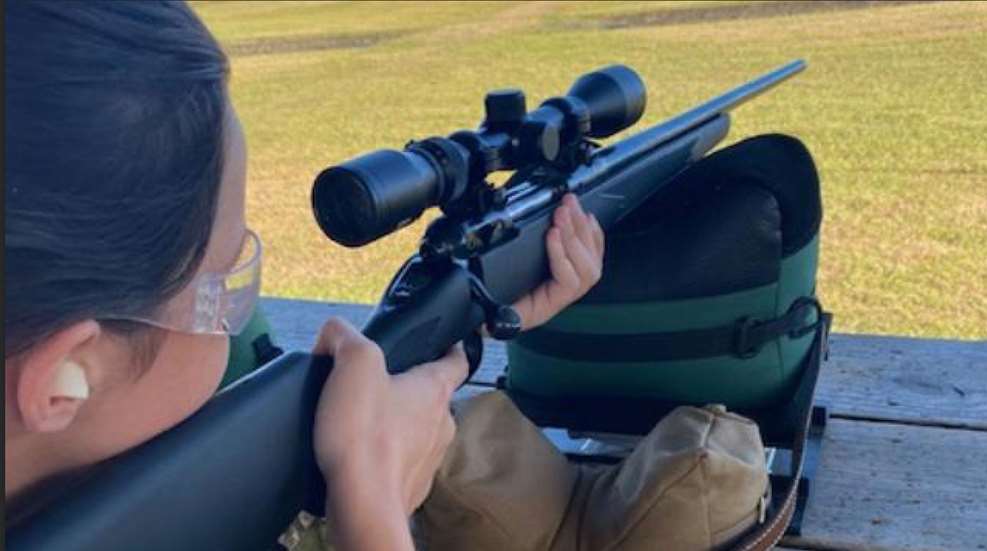3 Rifle Techniques to Take From the Bench to the Field
Tags:
3 Rifle Techniques to Take From the Bench to the Field
If you are a hunter and want to increase your chance of success in the field, practice these three things regularly.
by HEIDI LYN RAO posted on February 6, 2024
NEWS, LIFESTYLE, HOW-TO, HUNTING
Support NRA Women DONATE

There are two types of individuals who practice at the rifle range: target shooters who want to improve their shooting skills for competition, self-protection or enjoyment as a hobby; and those who want to improve their marksmanship as hunters.
Hunters make sure that their rifles are sighted in, and they practice to ensure they can take a quick, clean and ethical kill. For hunters, ensuring a good kill is more than practicing at the range for marksmanship. It has a lot to do with technique while shooting.
If you are a hunter and want to increase your chance of success in the field, there are three things you can do at the range: load your firearms by feeding from the magazine; cycle your firearm immediately after shot follow-through; and practice “nasty shooting.”
Feeding from The Magazine
You should always load your rifle by feeding the cartridges from the magazine to the chamber by working the action. There is a real possibility that loading a firearm in a manner not described in the owner’s manual can prevent a firearm from going into battery. Feeding ammunition from the magazine is how most firearms are designed to operate. By skipping the process of loading the magazine first, the potential of a firearm malfunction or stoppage significantly increases.
The most common type of rifle action is the push-feed bolt. A push-feed bolt does not lock onto the cartridge until the bolt is locked into place by the locking lugs. It also makes for ease of loading at the range because all you have to do is drop a round into the breech and close the bolt. It is common when shooters are practicing or sighting in a rifle at the range to put one round in at a time, loading their firearm by dropping a cartridge straight into the breech.
The problem arises when a control-feed bolt is introduced into the loading and firing sequence. A control-feed rifle bolt grasps the cartridge by the head and stays attached until the case is ejected. Because of the way the control feed is designed, a cartridge cannot be dropped into the breech to load. These types of bolts must be fed through the magazine.
If you feed a cartridge through the breech of a control-feed bolt, the round may become lodged in the chamber. Because the bolt never grabbed the head of the cartridge, the extractor is not sitting in the extractor groove of the cartridge since the bolt cannot fully close. If this happens, the ammunition source should be removed, and the bolt should be removed. A cleaning rod can now be pushed through the muzzle to push the stuck cartridge out of the breech.
Cycle After Shot Follow Through
There are 5 Fundamentals of Pistol and Rifle Shooting that every good marksman must adhere to for the proper and safe use of firearms. These are: aiming, breath control, hold control, trigger control and follow through. Follow through is the continuation of these fundamentals after the shot is fired. There is a sixth fundamental that hunters need to practice. Hunters need to cycle the action of their firearm after they follow through their last shot, before raising their head off the stock and looking down range. This means that the shooter should keep the rifle’s sights or the scope’s crosshairs on the target throughout the process of cycling the action.
Most shooters at the range load one round at a time, shoot, open the bolt, and let the barrel and receiver cool down before they load another round. This process of letting the rifle go through the cooling down process can still be done because you do not have to fire the second round. After the shooter cycles the second round, he or she should then open the action, remove the cartridge, and allow the firearm to cool down.
You should load at least two cartridges into the firearm’s magazine, then follow the five fundamentals Immediately after follow through, the shooter should cycle the action while keeping the sights aligned on the target. The action can now be opened for the cool down process.
The reason why you should cycle the action after follow through is so you are ready for a follow up shot, if necessary. Many times, you may need to take a second shot at a large game animal to put it down and prevent any wounding loss. When dealing with dangerous game animals, a second follow up shot is oftentimes advisable for safety.
Cycling a second round should come naturally and automatically at the range. In other words, the hunter practicing at the range should cycle another round into his or her firearm after a shot, without thinking about it. If a hunter does not practice cycling the action after their shot, he or she will usually not be able to take a follow up shot when one is needed. This is because of the excitement, adrenaline rush, buck fever, fear (of large claws and teeth), or any other emotion that comes along with hunting.
Practice Nasty Shooting
One of the most important things a hunter should practice at the range is “nasty shooting.” That means shooting in the worst conditions possible. Any hunter will tell you that when they head to the field it is either hot, cold, dry, wet, muddy, windy, still, stormy, beautiful, etc. When you are in the field hunting, you are apt to be in any weather condition, or even multiple conditions, all in the same day.
Because weather and field conditions can be extreme, hunters should be prepared to deliver their bullet to their intended target, no matter what the condition. This means practice in these conditions. Gun ranges tend to be vacant in adverse or bad weather conditions. A true hunter will head to the range in the worst of conditions because they know they will probably be hunting in those same conditions.
Hunters should always practice in the conditions at the range that closely match when they will be pulling the trigger in the field. For example, if the deer you are hunting show right at sunrise or sunset, you should be practicing at the outdoor range at those same times. Just remember that bullets impact the target differently at sunrise than at sunset, at different times of the day, and with changing weather conditions, including temperature.
Although the bullet impact area may vary throughout the day, it is very small, if even noticeable at all. It is important to understand that even though the bullet impact area is slightly different throughout the day, it can become amplified in extreme weather conditions. Practicing in extreme weather conditions will better prepare a hunter to make that quick, clean and ethical kill.
